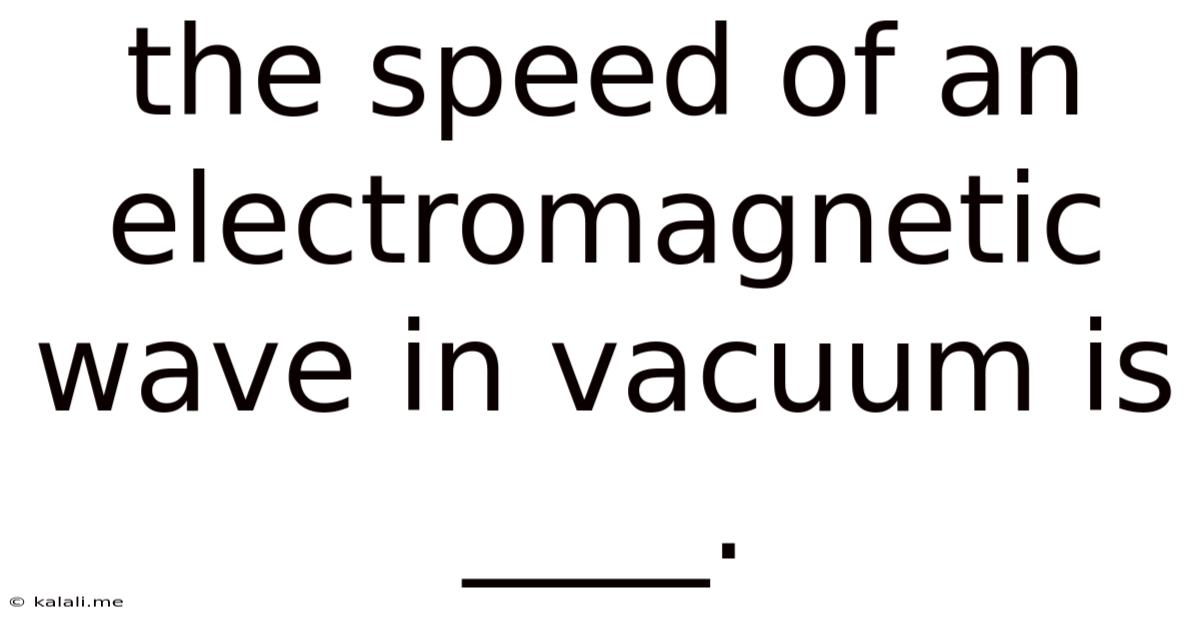The Speed Of An Electromagnetic Wave In Vacuum Is ____.
Kalali
Jun 11, 2025 · 3 min read

Table of Contents
The Speed of an Electromagnetic Wave in Vacuum is 299,792,458 m/s: Understanding Light's Constant Velocity
The speed of an electromagnetic wave in a vacuum is a fundamental constant in physics, representing the ultimate speed limit in the universe. This constant, often denoted as 'c', is precisely 299,792,458 meters per second. This isn't just a randomly chosen number; it's a cornerstone of our understanding of electromagnetism and relativity. This article will delve into why this speed is so important and what it signifies.
Understanding this constant velocity is crucial for comprehending various aspects of physics, from the behavior of light and other electromagnetic radiation to the principles of special relativity. Let's explore the significance of this number and its implications.
The Significance of 'c'
The speed of light in a vacuum, 'c', is not merely the speed of visible light; it's the speed at which all electromagnetic radiation travels in a vacuum. This includes:
- Radio waves: Used in communication and broadcasting.
- Microwaves: Used in cooking and communication.
- Infrared radiation: Felt as heat.
- Visible light: The portion of the electromagnetic spectrum detectable by the human eye.
- Ultraviolet radiation: Invisible light that can cause sunburn.
- X-rays: Used in medical imaging.
- Gamma rays: High-energy radiation emitted by radioactive materials.
All these forms of radiation, despite their differing wavelengths and frequencies, travel at the same constant speed in a vacuum. This consistency is a key feature of Maxwell's equations, which unified electricity, magnetism, and light as different manifestations of the same phenomenon: electromagnetism.
Why is it a Constant?
The constancy of 'c' is a consequence of the fundamental properties of space and time. According to Einstein's theory of special relativity, the speed of light in a vacuum is invariant – it's the same for all observers, regardless of their relative motion or the motion of the source of the light. This seemingly counterintuitive principle has profound implications for our understanding of space, time, and simultaneity.
The fact that 'c' is constant leads to several remarkable consequences, including:
- Time dilation: Time slows down for objects moving at high speeds relative to a stationary observer.
- Length contraction: The length of an object appears shorter in the direction of its motion.
- Relativistic mass increase: The mass of an object increases as its speed approaches the speed of light.
'c' and the Definition of the Meter
Interestingly, the speed of light in a vacuum plays a role in defining fundamental units of measurement. The meter, the standard unit of length in the International System of Units (SI), is defined based on the speed of light. One meter is the distance light travels in a vacuum in 1/299,792,458 of a second. This means that the speed of light in a vacuum is, by definition, a fixed constant.
The Speed of Light in Other Media
It's crucial to remember that the speed of light is only 299,792,458 m/s in a vacuum. When light travels through a medium like air, water, or glass, its speed is slower. This reduction in speed is due to the interaction of light with the atoms and molecules of the medium. The refractive index of a material describes how much slower light travels in that material compared to a vacuum.
In conclusion, the speed of an electromagnetic wave in a vacuum, 299,792,458 m/s, is a fundamental constant with far-reaching implications for our understanding of the universe. Its constancy is a cornerstone of modern physics and shapes our understanding of space, time, and the nature of light itself.
Latest Posts
Latest Posts
-
How Many Shots In A Half Gallon
Jul 01, 2025
-
Someone Once Told Me The World Was Macaroni
Jul 01, 2025
-
How Long Does It Take To Walk Five Miles
Jul 01, 2025
-
How Many Ounces Is A Pint Of Blueberries
Jul 01, 2025
-
How Many Dimes Are In 5 Dollars
Jul 01, 2025
Related Post
Thank you for visiting our website which covers about The Speed Of An Electromagnetic Wave In Vacuum Is ____. . We hope the information provided has been useful to you. Feel free to contact us if you have any questions or need further assistance. See you next time and don't miss to bookmark.